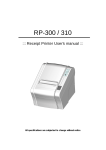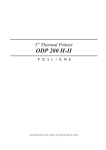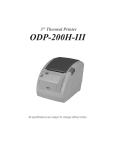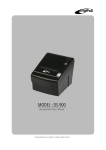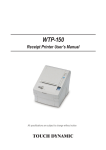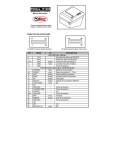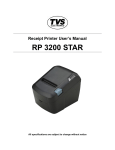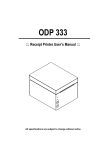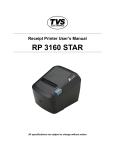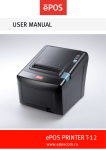Download DigiPos DS-810 User`s manual
Transcript
DS-800
::: Receipt Printer User’s manual :::
All specifications are subjected to change without notice
TABLE OF CONTENTS
1. Parts Identifications
2
2. Setting up the printer
3
2.1 Unpacking
3
2.2 Connecting the cables
4
2.3 Loading the roll paper
7
2.4 Dip switch setting
9
3. Control panel and other functions
13
3.1 Control panel
13
3.2 Error Indicating
13
4. Self Test
14
5. Hexadecimal Dump
14
6. Specifications
15
6.1 Environmental Conditions
15
6.2 Reliability
15
6.3 Certification
15
7. Command List
16
Page - 1-
1. Parts Identifications
Page - 2-
2. Setting Up the Printer
2-1. Unpacking
Your printer box should include these items. If any items are damaged or missing, please
contact your dealer for assistance.
Page - 3-
Adaptor (Option)
Interface Cable (Option)
2-2. Connecting the Cables
You can connect up the cables required for printing to the printer. They all connect to the
connector panel on the back of the printer, which is shown below :
Page - 4-
Before connecting any of the cables, make sure that both the printer and the computer are
turned off.
Page - 5-
2-2-1. Interface Connector
<D-SUB 25 Female Serial Port>
<D-SUB Centronics Parallel Port>
<4Pin “ B” Type USB Port>
- Serial interface
PIN
SIGNAL
I/O
DESCRIPTION
2
TxD
Output
Printer transmit data line RS-232C level
3
RxD
Input
Printer receive data line RS-232C level
4, 20
DTR
Output
6
DSR
Input
1, 7
GND
-
Printer handshake to host line RS-232C level
Data Send Ready
System Ground
- USB interface
Page - 6-
PIN
SIGNAL
I/O
DESCRIPTION
1
+5V
-
+5V
2
DATA-
-
Printer transmit data line
3
DATA+
-
Printer transmit data line
4
GND
-
System Ground
- Centronics Parallel interface
PIN
SIGNAL
I/O
DESCRIPTION
1
STROBE-
Input
2~9
DATA0~7
Input/Output
Data bit Transmitted 0~7
10
ACK-
Output
Data receiving completed.
11
BUSY
Output
Impossible to print of data receiving.
12
PE
Output
Paper empty
13
SELECT
Output
Printer status for ON/OFF line
14
AUTO FEED-
15
GROUND
-
System ground
16
GROUND
-
System ground
17
NC
-
18
LOGIC-H
-
+5V
19~30
GROUND
-
System ground
31
INIT-
32
ERROR-
Output
33
GROUND
-
34
NC
-
35
+5V
-
36
SELLECT IN-
Input
Input
Synchronize signal Data received
Paper auto feed signal
Initialize
Printer error
System ground
+5V
Input
Printer select signal
2-2-2. Cash Drawer Connector
The printer can operate two cash drawers with a 6 pin RJ-11 modular connector. The driver is
capable of supplying a maximum current of 1.0A for 510ms or less when not printing.
Page - 7-
PIN
SIGNAL
1
Signal GND
2
Drawer kick-out drive signal 1
3
Drawer open/close signal
4
+24V
5
Drawer kick-out drive signal 2
6
Signal GND
DESCRIPTION
Output
Input
Output
-
2-3. Loading the Roll Paper
Notes: Be sure to use paper rolls that meet the specifications. Do not use paper rolls that
have the paper glued to the core because the printer cannot detect the paper end correctly.
(Turn off power switch)
☞ Turn off power switch.
1. Make sure that the printer is not receiving data; Otherwise, data may be lost.
2. Open the paper roll cover by pulling down the cover-open lever.
Page - 8-
3. Remove the used paper roll core if there is one inside.
4. Insert new paper roll as shown.
5. Be sure to note the correct direction that the paper comes off the roll.
Page - 9-
6. Pull out a small amount of paper, as shown. Then, close the cover.
7. Tear off the paper as shown.
2-4. DIP SWITCH SETTING
The printer is set up at the factory to be appropriate for almost all users. It does, however, offer
some settings for users with special requirements.
It has DIP switches that allow you to change communication setting, such as handshaking and
parity check, as well as print density.
Your printer has two sets of DIP switches. The functions of the switches are shown in the
Page - 10-
following tables.
※Note : Power off. And open the cover of Dip Switch and change setting.
2-4-1. Serial Interface Specification
DIP Switch Set 1 Functions
SW
FUNCTION
ON
OFF
Ignore
DEFAULT
1
Data Receive Error
Print “ ?”
OFF
2
Hexadecimal
HEXDUMP
NORMAL
OFF
3
Hand Shaking
XON/OFF
DTR/DSR
OFF
4
Data Length
7bits
8bits
OFF
5
Parity Check
ENABLED
DISABLED
OFF
6
Parity Check
EVEN
ODD
OFF
Baud rate selection
Transmission speed
SW-7
SW-8
4800 baud
ON
ON
9600 baud
OFF
ON
19200 baud
ON
OFF
38400 baud
OFF
OFF
Print Density
SW-1
SW-2
Lower Power
ON
ON
Normal
OFF
ON
Normal
ON
OFF
Dark
OFF
OFF
DIP Switch Set 2 Functions
Print Density
Cutter
SW
FUNCTION
ON
OFF
Remarks
3
Cutter
FULL CUT
PARTIAL CUT
Only Epson mode
Emulation
Page - 11-
FUNCTION
SW-4
SW-5
Epson (TM-88)
OFF
OFF
Paper low detect
SW
FUNCTION
ON
OFF
6
Paper Low
Detect
Do not Detect
2-4-2. Parallel Interface Specification
DIP Switch Set 1 Function
SW
FUNCTION
ON
OFF
DEFAULT
-
-
OFF
HEXDUMP
NORMAL
OFF
1
Reserved
2
Hexadecimal
3
Reserved
-
-
OFF
4
Reserved
-
-
OFF
5
Parallel mode
UNIDIRECTION
BIDIRECTION
OFF
6
Reserved
-
-
OFF
Baud rate selection
Transmission speed
SW-7
SW-8
DEFAULT
Reserved
-
-
OFF
Reserved
-
-
OFF
Reserved
-
-
OFF
Reserved
-
-
OFF
DIP Switch Set 2 Functions
Print Density
Print Density
SW-1
SW-2
Lower Power
ON
ON
Normal
OFF
ON
Normal
ON
OFF
Dark
OFF
OFF
Page - 12-
Cutter
SW
3
FUNCTION
Cutter
ON
OFF
Remarks
FULL CUT
PARTIAL CUT
Only Epson mode
Emulation
FUNCTION
SW-4
SW-5
Epson (TM-88)
OFF
OFF
Paper low detect
SW
FUNCTION
ON
OFF
6
Paper Low
Detect
Do not Detect
☞ CAUTION:
Turn off the printer while removing the DIP switch cover to prevent an electric short, which can
damage the printer.
1. Make sure the printer is turned off.
2. Remove the screw from the DIP switch cover. Then, take off the DIP switch cover as shown
in the illustration below.
Page - 13-
3. Set the switches using a pointed toll, such as tweezers or a small screwdriver.
4. Replace the DIP switch cover. Then, secure it with the screw.
The new settings take effect when you turn on the printer.
Page - 14-
☞ CAUTION:
When the paper is jammed with cutter, the top cover might be stuck. In this case, repeat power
on and off several times.
If the top cover is still stuck, please follow the steps to release the papers from jamming.
1. Make sure the printer is turned off.
2. Take out cutter cover as shown.
3. Turn screw with drivers to a direction until paper is released from the cutter.
Page - 15-
3. Control panel and other functions.
3-1. Control panel
You can control the basic paper feeding operations of the printer with the button on the control
panel. The indicator lights help you to monitor the printer’ s status.
Control Panel
POWER
ERROR
PAPER
FEED
Button
The button can be disabled by the ESC c 5 command.
Page - 16-
Press the FEED button once to advance paper one line. You can also hold down the FEED
button to feed paper continuously.
3-2. Error indicating
This section explains the different patterns signaled by the two LED indicators located on the
top cover of the printer.
PAPER
ERROR
POWER
RED
RED
GREEN
Power off
OFF
OFF
OFF
Normal power is not supplied to the printer
Power on
OFF
OFF
ON
Normal power is supplied to the printer
On line
OFF
OFF
ON
Normal error-free mode
Cover open
OFF
ON
ON
Close cover
Paper empty
OFF
ON
ON
Insert new paper roll
Paper near end
ON
OFF
ON
Paper is low
Test mode
OFF
OFF
ON
Ignored error led
STATUS
REMARKS
4. Self Test
The self-test lets you know if your printer is operating properly. It checks the control circuits,
printer mechanisms, print quality, ROM version and DIP switch settings.
This test is independent of any other equipment or software.
Running the self test
1. Make sure the printer is turned off and the printer cover is closed properly.
2. While holding down the FEED button, turn on the printer using the switch on the front of the
Page - 17-
printer to begin the self-test. The Self Test prints the printer settings and then prints the
following, Cuts the paper, and pauses. (Error LED On)
Self test Printing
Please press the PAPER FEED button.
3. Press the FEED button to continue printing. The printer prints a pattern using the built-in
character set.
4. The self test automatically ends and cuts the paper after printing the following:
*** Completed ***
The printer is ready to receive data as soon as it completes the self-test.
5. Hexadecimal Dump
This feature allows experienced users to see exactly what data is coming to the printer. This can
be useful in finding software problems.
When you turn on the hex dump function, the printer prints all commands and other data in
hexadecimal format along with a guide section to help you find specific commands.
To use the hex dump feature, follow these steps:
1. After you make sure that the printer is off and Dip s/w 1-2 is ON, turn on the printer.
2. Run any software program that sends data to the printer. The printer prints “ Hexadecimal
Dump” and then all the codes it receives in a two-column format. The first column contains the
hexadecimal codes and the second column gives the ASCⅡ characters that correspond to the
codes.
Hexadecimal Dump
1B 21 00 1B 26 02 40 40 .!..& . @ @
1B 25 01 1B 63 34 00 1B .%.. c4 ..
41 42 43 44 45 46 47 48 ABCDEFGH
□ A period (.) is printed for each code that has no ASCⅡ equivalent.
3. Turn off the printer, and make sure that Dip sw 1-2 off.
Page - 18-
4. Turn on the printer.
6. Specifications
Important!
When using a printer power supply other than optional AC adaptor (HT-U1135, LSE
9901B2460), be sure that the following cautions are observed.
Use a power supply (Limited Power Supply) of DC 24V±10% and more than 1.5A.
Be careful about installing the printer in an area where there is noise.
Take the appropriate measure to protect against electrostatic AC line noise, etc.
6-1. Environmental Requirements
(1)Operating
Temperature
5°C to 45°C
Humidity
10% to 90% RH (without condensation)
(2)Transport/Storage (except paper)
Temperature
-20°C to 60°C
Humidity
10% to 90% RH (without condensation)
6-2. Reliability
(1)MCBF
50 million lines (based on an average printing rate of 12.5% with paper
thickness in the range 65µm to 75µm)
35 million lines (based on an average printing rate of 12.5% with paper
thickness in the range 76µm to 150µm)
(2)Head Life
100 million pulses, 100Km
(3)Cutter Life
1.0 million cuttings (if the paper thickness is between 65 and 90µm)
Page - 19-
6-3. Certification
(1)FCC PART15 CLASS A
(2)CE EMCD/LVD
(3)UL/cUL
(4)MIC
7. Command List
No.
Command
Function
1
HT
Horizontal tab
2
LF
Print and line feed
3
CR
Print and carriage return
4
FF
Print end position label to start printing
5
CAN
Cancel print data in page mode
6
DLE EOT
Real-time status transmission
7
DLE ENQ
Real-time request to printer
8
DLE DC4
Generate pulse at real-time
9
ESC FF
Print data in page mode
10
ESC SP
Set character right-side spacing
11
ESC !
Set print mode
12
ESC $
Select/cancel user-defined character set
13
ESC %
Define user-defined characters
14
ESC &
Turn underline mode on/off
15
ESC *
Set bit image mode
16
ESC -
Turn underline mode on/off
17
ESC 2
Set 1/6 inch line spacing
18
ESC 3
Set line spacing using minimum units
Page - 20-
REMARKS
19
ESC =
Select peripheral device
20
ESC ?
Cancel user-defined characters
21
ESC @
Initialize printer
22
ESC D
Set horizontal tab positions
23
ESC E
Select emphasized mode
24
ESC G
Select double-strike mode
25
ESC J
Print end feed paper using minimum units
26
ESC L
Select page mode
27
ESC M
Select character font
28
ESC R
Select international character set
29
ESC S
Select standard mode
30
ESC T
Select print direction in page mode
31
ESC V
Set/cancel 90 cw rotated character
32
ESC W
Set printing area in page mode
33
ESC \
Set relative position
34
ESC a
Align position
35
ESC c 3
Select paper sensor(s) to output paper-end signals
36
ESC c 4
Select paper sensor(s) to stop printing
37
ESC c 5
Enable/disable panel buttons
38
ESC d
Print and feed paper n lines
39
ESC p
General pulse
40
ESC t
Select character code table
41
ESC {
Set/cancel upside-down character printing
42
FS p
Print NV bit image
43
FS q
Define NV bit image
44
GS !
Select character size
45
GS $
Set absolute vertical print position in page mode
46
GS *
Define downloaded bit image
47
GS /
Print down-loaded bit image
48
GS B
Turn white/black reverse printing mode on/off
49
GS H
Select printing position of HRI characters
50
GS I
Transmit printer ID
51
GS L
Set left margin
52
GS P
Set horizontal and vertical motion units
53
GS V
Cut paper
54
GS W
Set printing area width
55
GS \
Set relative vertical print position in page mode
56
GS a
Enable/disable Automatic Status Back (ASB)
Page - 21-
57
GS f
Select font for HRI characters
58
GS h
Set bar code height
59
GS k
Print bar code
60
GS r
Transmit status
61
GS v 0
Print raster bit image
62
GS w
Set bar code width
< Add >
1
ESC i
Full cut
2
ESC m
Partial cut
3
FS !
Set print mode(s) for Kanji characters
4
FS &
Select Kanji character mode
5
FS -
Turn underline mode on/off for Kanji character
6
FS .
Cancel Kanji character mode
7
FS 2 c1 d1…dk
Define user-defined Kanji characters
8
FS C
Select Kanji character code system
9
FS S 1 2
Set left-and right-side Kanji character spacing
10
FS W
Turn quadruple-size mode on/off for Kanji character
Page - 22-
:: MEMO ::
Page - 23-
:: MEMO ::
Page - 24-
:: MEMO ::
Page - 25-
Page - 26-



























